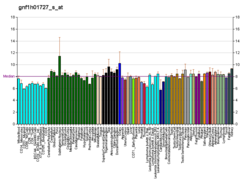GPR98
ADGRV1,also known asG protein-coupled receptor 98(GPR98) or Very Large G-protein coupled receptor 1 (VLGR1), is aproteinthat in humans is encoded by theGPR98gene.[5]Several alternatively spliced transcripts have been described.[5]
The adhesion GPCR VLGR1 is the largest GPCR known, with a size of 6300 amino acids and consisting of 90 exons.[6]There are 8 splice variants of VlgR1, named VlgR1a-1e and Mass1.1-1.3. TheN-terminusconsists of 5800 amino acids containing 35 Calx-beta domains, one pentraxin domain, and one epilepsy associated repeat. Mutations of VlgR1 have been shown to result in Usher's syndrome. Knockouts of Vlgr1 in mice have been shown to phenocopy Usher's syndrome and lead to audiogenic seizures.
Function
[edit]This gene encodes a member of theadhesion-GPCRfamily of receptors.[7]The protein binds calcium and is expressed in the central nervous system. It is also known asvery large G-protein coupled receptor 1because it is 6300 residues long. It contains a C-terminal 7-transmembrane receptor domain, whereas the large N-terminal segment (5900 residues) includes 35 calcium bindingCalx-beta domains,and 6EAR domains.
Evolution
[edit]Thesea urchingenome has a homolog of VLGR1 in it.[8]
Clinical significance
[edit]Mutations in this gene are associated withUsher syndrome2 and familial febrile seizures.[5]
References
[edit]- ^abcGRCh38: Ensembl release 89: ENSG00000164199–Ensembl,May 2017
- ^abcGRCm38: Ensembl release 89: ENSMUSG00000069170–Ensembl,May 2017
- ^"Human PubMed Reference:".National Center for Biotechnology Information, U.S. National Library of Medicine.
- ^"Mouse PubMed Reference:".National Center for Biotechnology Information, U.S. National Library of Medicine.
- ^abc"Entrez Gene: GPR98 G protein-coupled receptor 98".
- ^Sun JP, Li R, Ren HZ, Xu AT, Yu X, Xu ZG (May 2013). "The very large G protein coupled receptor (Vlgr1) in hair cells".Journal of Molecular Neuroscience.50(1): 204–214.doi:10.1007/s12031-012-9911-5.PMID23180093.S2CID16730555.
- ^Stacey M, Yona S (2011).AdhesionGPCRs: Structure to Function (Advances in Experimental Medicine and Biology).Berlin: Springer.ISBN978-1-4419-7912-4.
- ^Whittaker CA, Bergeron KF, Whittle J, Brandhorst BP, Burke RD, Hynes RO (December 2006)."The echinoderm adhesome".Developmental Biology.300(1): 252–266.doi:10.1016/j.ydbio.2006.07.044.PMC3565218.PMID16950242.
Further reading
[edit]- Staub E, Pérez-Tur J, Siebert R, Nobile C, Moschonas NK, Deloukas P, et al. (September 2002). "The novel EPTP repeat defines a superfamily of proteins implicated in epileptic disorders".Trends in Biochemical Sciences.27(9): 441–444.doi:10.1016/S0968-0004(02)02163-1.PMID12217514.
- Ishikawa K, Nagase T, Suyama M, Miyajima N, Tanaka A, Kotani H, et al. (June 1998)."Prediction of the coding sequences of unidentified human genes. X. The complete sequences of 100 new cDNA clones from brain which can code for large proteins in vitro".DNA Research.5(3): 169–176.doi:10.1093/dnares/5.3.169.PMID9734811.
- Nakayama J, Hamano K, Iwasaki N, Nakahara S, Horigome Y, Saitoh H, et al. (January 2000)."Significant evidence for linkage of febrile seizures to chromosome 5q14-q15".Human Molecular Genetics.9(1): 87–91.doi:10.1093/hmg/9.1.87.PMID10587582.
- Pieke-Dahl S, Möller CG, Kelley PM, Astuto LM, Cremers CW, Gorin MB, et al. (April 2000)."Genetic heterogeneity of Usher syndrome type II: localisation to chromosome 5q".Journal of Medical Genetics.37(4): 256–262.doi:10.1136/jmg.37.4.256.PMC1734554.PMID10745043.
- Nikkila H, McMillan DR, Nunez BS, Pascoe L, Curnow KM, White PC (September 2000). "Sequence similarities between a novel putative G protein-coupled receptor and Na+/Ca2+ exchangers define a cation binding domain".Molecular Endocrinology.14(9): 1351–1364.doi:10.1210/me.14.9.1351.PMID10976914.
- Wiemann S, Weil B, Wellenreuther R, Gassenhuber J, Glassl S, Ansorge W, et al. (March 2001)."Toward a catalog of human genes and proteins: sequencing and analysis of 500 novel complete protein coding human cDNAs".Genome Research.11(3): 422–435.doi:10.1101/gr.GR1547R.PMC311072.PMID11230166.
- Skradski SL, Clark AM, Jiang H, White HS, Fu YH, Ptácek LJ (August 2001)."A novel gene causing a mendelian audiogenic mouse epilepsy".Neuron.31(4): 537–544.doi:10.1016/S0896-6273(01)00397-X.PMID11545713.S2CID14468960.
- McMillan DR, Kayes-Wandover KM, Richardson JA, White PC (January 2002)."Very large G protein-coupled receptor-1, the largest known cell surface protein, is highly expressed in the developing central nervous system".The Journal of Biological Chemistry.277(1): 785–792.doi:10.1074/jbc.M108929200.PMID11606593.
- Nagase T, Kikuno R, Ohara O (December 2001). "Prediction of the coding sequences of unidentified human genes. XXII. The complete sequences of 50 new cDNA clones which code for large proteins".DNA Research.8(6): 319–327.doi:10.1093/dnares/8.6.319.PMID11853319.
- Nakayama J, Fu YH, Clark AM, Nakahara S, Hamano K, Iwasaki N, et al. (November 2002). "A nonsense mutation of the MASS1 gene in a family with febrile and afebrile seizures".Annals of Neurology.52(5): 654–657.doi:10.1002/ana.10347.PMID12402266.S2CID36357793.
- Ota T, Suzuki Y, Nishikawa T, Otsuki T, Sugiyama T, Irie R, et al. (January 2004)."Complete sequencing and characterization of 21,243 full-length human cDNAs".Nature Genetics.36(1): 40–45.doi:10.1038/ng1285.PMID14702039.
- Weston MD, Luijendijk MW, Humphrey KD, Möller C, Kimberling WJ (February 2004)."Mutations in the VLGR1 gene implicate G-protein signaling in the pathogenesis of Usher syndrome type II".American Journal of Human Genetics.74(2): 357–366.doi:10.1086/381685.PMC1181933.PMID14740321.
- Bjarnadóttir TK, Fredriksson R, Höglund PJ, Gloriam DE, Lagerström MC, Schiöth HB (July 2004). "The human and mouse repertoire of the adhesion family of G-protein-coupled receptors".Genomics.84(1): 23–33.doi:10.1016/j.ygeno.2003.12.004.PMID15203201.
- Fu GK, Wang JT, Yang J, Au-Young J, Stuve LL (July 2004). "Circular rapid amplification of cDNA ends for high-throughput extension cloning of partial genes".Genomics.84(1): 205–210.doi:10.1016/j.ygeno.2004.01.011.PMID15203218.
- Schwartz SB, Aleman TS, Cideciyan AV, Windsor EA, Sumaroka A, Roman AJ, et al. (February 2005). "Disease expression in Usher syndrome caused by VLGR1 gene mutation (USH2C) and comparison with USH2A phenotype".Investigative Ophthalmology & Visual Science.46(2): 734–743.doi:10.1167/iovs.04-1136.PMID15671307.
- Kimura K, Wakamatsu A, Suzuki Y, Ota T, Nishikawa T, Yamashita R, et al. (January 2006)."Diversification of transcriptional modulation: large-scale identification and characterization of putative alternative promoters of human genes".Genome Research.16(1): 55–65.doi:10.1101/gr.4039406.PMC1356129.PMID16344560.







